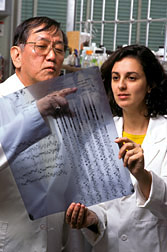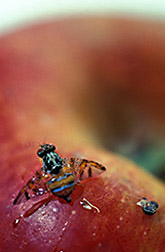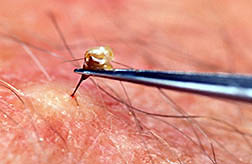|
|
DNA—Sequencing is a New Tool for Insect Detectives
Amid the priceless artifacts at the Egyptian Museum in Torino, Italy, Steve Sheppard prepared to remove pieces of 3,000-year-old honey bees imbedded in beeswax.
The museum curators were anxious—hovering "about 6 inches away from me," Sheppard recalls—as he removed leg fragments of honey bees that got caught in the wax so long ago. The U.S. Department of Agriculture scientist brought the bee pieces back to his laboratory in Beltsville, Maryland, where he hopes they'll help shed light on the honey bee's evolution.
He'll attempt to extract genetic material from those bee parts. The goal: to see if he can get a portion of the bee's genetic sequence—a fingerprint, so to speak—of that insect. Then he'll compare the 3,000-year-old sequence with that of the same honey bee race today. The idea is to determine the rate of change in the genetic material. That information can be used to study how the honey bee diversified into the 25 races known today.
An entomologist with USDA's Agricultural Research Service, Sheppard is one of many agency scientists who are sequencing and fingerprinting insects—some of which are on the "most wanted list" of crop destroying pests.
This entomological detective work could help scientists take out of commission culprits such as Mediterranean fruit flies, corn earworms, mosquitoes, sweet potato whiteflies, biting midges, Indianmeal moths, and potato leafhoppers.
One of the basic rules of any investigation is to properly identify the suspect. Scientists do that by developing fingerprints from insect genetic material called DNA, deoxyribonucleic acid. DNA is present not only in insects, but in all living organisms. As ARS geneticist S. Karl Narang says, DNA is the "master molecule of inheritance," making each living organism unique.
 |
All DNA--whether from bacteria, insects, plants, or higher animals—is made up of four chemicals, with the initials A, T, C, and G. These four chemicals are arranged in patterns—known as sequences—that can stretch into the millions, even billions. It is variation in these sequences that scientists can use to form a genetic fingerprint.
Genetic fingerprinting has gained headlines because of its use as forensic evidence in criminal trials, particularly in high-profile cases. Genetic fingerprints have played a key role in freeing death-row prisoners and convicting criminal suspects. They are also being used to establish paternity, or nonpaternity, thereby lessening the problem of false accusation.
Even whales have come under DNA scrutiny. Recently, scientists reported that they were able to establish, through DNA tests, that whale meat purchased in the Far East came from a species that was supposed to be protected by an international moratorium on commercial whaling.
Medflies Are Targeted
|
|
Two of the higher profile insect suspects to be targeted for DNA identification are Mediterranean fruit flies and Africanized honey bees. Tracking the sources of these two insects is important for regulatory agencies that are trying to monitor and, if possible, stop their spread.
Over the last several years, Sheppard and colleagues at Penn State University and the Florida Department of Agriculture have studied medflies found in California. Medflies are one of the most serious fruit and vegetable pests in tropical and subtropical areas of the world. The flies not only damage fruit, but cause export problems because other countries will not accept fruit from fly-infested areas.
To protect the state's export crop, California and USDA have spent millions to eradicate the fly in recent years.
California regulators want to know where the flies are coming from, and Sheppard and colleagues are using DNA tests to help answer that question.
They aren't sure exactly where the medflies are originating, but Sheppard says those they found in California have the same genetic markers as wild medflies from Nigeria, Guatemala, Argentina, and parts of Central and South America.
Genetic markers are DNA fragments that can show similarities among insects. To get them, the scientists extracted DNA from mitochondria, the power plants of all animal cells that produce the chemical energy organisms need to live.
They used special enzymes to cut the mitochondrial DNA and create a pattern of DNA fragments that could be used as genetic markers. Then they examined markers in eight wild fly populations from around the world, including Venezuela, Nigeria, Liberia, Guatemala, and California—and compared them to seven wild populations from Hawaii.
It was the first time analysis with mitochondrial DNA had been used to identify potential sources of medflies—knowledge that could be used to help control future outbreaks.
Sheppard's group concluded that Hawaii does not appear to be the source of the medflies that have been found in California over the last 5 or 6 years.
|
|
Bee Stingers Yield Genetic Markers
Was that an Africanized or European honey bee that stung you in the arm? The answer, say Shepard and colleagues Hachiro Shianuki and M. Cristina Arias of the Beltsville (Maryland) Bee Laboratory, can now be found by examining DNA from the bee's stinger.
This is the first time scientists have established genetic markers in bee stingers, giving forensic entomologists a new tool to help determine the identity of honey bees. As in medflies, they obtained the markers from mitochondrial DNA.
DNA tests are particularly helpful with bee stingers, because they look the same—whether they're from Africanized or European honey bees. Sheppard cautioned that the method is experimental and has not yet been accepted for official identification of Africanized or European honey bees.
"But it can be helpful, especially in cases where the bees themselves cannot be recovered to use for identification," he said. "If we can recover the stinger from an animal or person who has been stung, we can—learn something about the genetic makeup of the bee that left the stinger."
Sheppard said genetic markers have helped researchers determine the effect of historical introductions of honey bees into the United States. Sheppard and Beltsville Bee lab entomologist Nathan Schiff have conducted DNA studies verifying that bees from Africa have been here longer than originally thought.
They've found genetic markers specific to one of two bee races that were brought into the United States from Africa in the 1800's and bred with wild populations predominately imported from Europe. Honey bees are not native to the United States.
The markers they found were from the African race Apis mellifera lamarckii, and the markers have survived over the last century. The scientists can use these markers to differentiate between A. m. lamarckii (originally from Egypt) and Africanized honey bees (derived from the race A. m. scutellatu) that have grabbed headlines since they were discovered in Texas in 1990.
At the Honey Bee Breeding, Genetics, and Physiology Research Laboratory in Baton Rouge, Louisiana, geneticists Allen Sylvester and Thomas Rinderer have begun to use DNA fingerprinting to track bee migration and mating patterns.
"The long-term goal is to give honey bee breeders more information on how they can control mating, particularly in areas where Africanized honey bees are expected," Sylvester says.
Sorting Out Mosquito Pests
There are thousands of mosquito species worldwide and perhaps 100 in Florida, where Andrew Cockburn works at the ARS Medical and Veterinary Entomology Research lab in Gainesville. Cockburn notes that of all the mosquitoes buzzing around on this planet, only a handful pose a health threat to humans.
"Most mosquitoes bite birds, rodents, and other wildlife, and most of the mosquitoes that bite humans don't transmit malaria or other diseases," says Cockburn, who studies mosquito DNA. "So one of the main goals behind our work is to be able to accurately identify mosquitoes, so we know what we're dealing with."
It makes little sense, he says, to conduct costly control programs against a mosquito that doesn't pose a health threat. "When you get down to it, you really do want to restrict control to mosquitoes that are a definite danger."
One mosquito Cockburn and Gainesville colleagues have studied is Anopheles quadrimaculatus, which is found in the eastern United States. It can transmit malaria but is now primarily a nuisance pest in this country.
Cockburn says there are five species in the United States that look like A. quadrimaculatus—so it's hard to tell them apart. He and entomologists Paul Kaiser and Truls Jensen unraveled some of the mystery by studying three of the look-alikes found in their area.
To collect the mosquitoes, they went to Manatee Springs State Park near Gainesville. They brought mosquitoes back to the lab, ground them up, extracted some of the juice, and analyzed the blood inside the insects. Cockburn says it's the first time this type of DNA fingerprinting has been used to detect the source of blood inside mosquitoes.
The scientists confirmed that only one of the three—called species A—was actually A. quadrimaculatus. It feeds on humans, while species B and C rarely do. Soon, the scientists will name species B and C, so it will be clear that they're different from A. quadrimaculatus.
"The fingerprinting has made it clear that species B and C shouldn't be considered a major problem for mosquito control agencies," he says.
Tackling the Corn Earworm
At the ARS Biosciences Research Laboratory in Fargo, North Dakota, geneticist S. Karl Narang and colleagues are using DNA fingerprinting to sort out origins of migratory corn earworms, one of the worst agricultural pests in the United States today. It attacks corn and a variety of other crops, causing hundreds of millions of dollars in losses each year.
One thing that makes this pest hard to control is that the adult moths can migrate up to 1,000 miles—meaning that if you knock out the pest in one area, it will simply fly in from somewhere else.
Narang is using DNA fingerprinting to pinpoint the migratory pattern of the moths, so that scientists can develop areawide strategies for controlling these pests. They've confirmed that the earworm/boll-worm insects migrate northward into the United States from Mexico. That's based on matching fingerprints from pests in northeastern Mexico with those in Georgia, Florida, Tennessee, Louisiana, Mississippi, Texas, and Oklahoma.
Insect Transmission of Bluetongue Virus
DNA fingerprinting is being used to identify insects that can spread bluetongue viruses among ruminant animals. The insects are biting midges, Culicoides variipennis, that transmit bluetongue. The disease may cause severe illness in sheep and occasional abortions in cattle.
Scientists at ARS' Arthropod-borne Animal Diseases Research Laboratory, in Laramie, Wyoming, have noted that the northeastern United States is bluetongue-free. The C. variipennis they found there are genetically different from those found in other regions of the country where the disease is present.
"We're developing a genetic map using DNA technology so we can demonstrate the genetic capability of insects to transmit pathogens.
"This will show to potential export markets that cattle from specific areas of the Northeast are not at risk and are disease-free," says Walter J. Tabachnick, an ARS entomologist at Laramie. "Nearly $120 million is lost annually because of trade restrictions on U.S. livestock and germplasm to bluetongue-free European countries."
They will identify specific genes that control whether an insect species or subspecies can carry the viruses from one animal to another. If these genes are not present in an insect population, then the livestock in that area will not harbor bluetongue.
Biocontrol for Sweet potato Whitefly
Scientists at ARS' Western Cotton Research Laboratory in Phoenix, Arizona, are using DNA technology to investigate ways to control the sweet potato whitefly, Bemisia tabaci.
Although the insect has been in this country for more than 100 years, the first serious outbreak of a new strain hit Florida in 1986.
The new strain of whitefly has recently been named B. argentifolii, silverleaf whitefly.
Since 1991, this pest has been blamed for annual crop damages estimated at more than $200 million to cotton and many vegetable and ornamental crops. Most of the damage has been in the warm-weather states of Florida, California, Arizona, and Texas.
Geneticist Alan C. Bartlett's detective work at Phoenix shows that there is a whole range of genetic variability among whiteflies around the world—a finding that has implications for controlling the pest.
"Earlier in our research, we were finding significant differences between the new flies that were damaging our crops and ones that had been here before.
"But further work revealed that other sweet potato whiteflies from around the world fit neatly into an emerging pattern. It was hard to say where one population ended and another began," says Bartlett.
Now researchers can develop control strategies that work on a whole range of whiteflies and don't focus attention on what some people call a distinct species.
DNA technology may also help identify biocontrol wasps that attack whiteflies. ARS scientists in Albany, California, are sleuthing the DNA of these helpful wasps, in hopes that this genetic material will provide a fast, foolproof key to distinguishing one wasp species from another.
"Right now, there's no easy way to figure out which wasps are the best at killing sweet potato whiteflies," explains Bruce Campbell of the ARS Western Regional Research Center at Albany. Adult whiteflies attack at least 600 plants.
More than a dozen kinds of friendly, stingerless wasps—some collected overseas by ARS entomologists—are now being raised in the United States in experiments to combat whitefly.
Identifying a winged adult wasp, which looks something like a miniature fly, can be difficult enough. But it's virtually impossible to speedily identify the offspring of those same wasps at the time it matters most; that is, when they've successfully parasitized the developing whitefly and are living as maggoty larvae inside it.
"With the ideal test," says Campbell, "you would squish the whitefly larvae, add a few drops of a chemical that acts like a DNA probe, and then look for a color change that reveals the wasp species."
Using lab-reared adult wasps of known identity, Campbell has found tell-tale differences in a short segment of DNA known as an internal transcribed spacer, or ITS.
His earlier work with some other wasps, as well as ants, proved that an ITS can be an accurate guide to differentiating species.
Campbell expects to know soon whether ITS probes prove a successful basis for a quick-acting test kit. The California Department of Food and Agriculture is funding part of the research.
Stored Product Insects
Entomologist Alan K. Dowdy of the U.S. Grain Marketing Research Laboratory in Manhattan, Kansas, is conducting insect DNA fingerprinting studies on the Indianmeal moth and lesser grain borer, which infest stored grain.
The work is aimed at determining both sources of infestations in grain and insect migration patterns.
Dowdy is sampling populations from different locations. Presently it's not known how much migration is due to commerce and how much is due to the insects' own flight. Various Indianmeal moths are resistant to certain chemical insecticides and the biological control agent Bacillus thuringiensis.
Fingerprinting should help Dowdy identify the resistant strains more easily than testing them for survival after exposure to the pesticides. Using DNA markers, he was able to consistently differentiate between populations of Indianmeal moths from separate geographic areas. Further research may lead to identification of populations that are susceptible or resistant to certain pesticides.
Protecting Alfalfa From Leafhoppers
DNA research on another migratory insect pest, the potato leafhopper, may help explain why efforts to breed resistance into alfalfa have so far proved elusive; the one-eighth-inch-long insects have a high degree of genetic variability, even within a field. So a variety of alfalfa may be unappetizing to one leafhopper but tasty to another.
Potato leafhoppers may be the most serious pest alfalfa has—inflicting season-long damage by sucking sap from the plant and injecting a toxin that makes leaves turn reddish yellow.
From one alfalfa field, geneticist Daniel Z. Skinner of the Plant Science and Entomology Research Unit at Manhattan examined 52 DNA fragments from each of 48 specimens. He found no two profiles that were similar.
Now the challenge is to develop in the laboratory several distinctly different leafhopper colonies with some genetic uniformity and test them against alfalfa varieties. Scientists may then develop alfalfa germplasm with multiple genes for resistance to genetically diverse leafhoppers.
Skinner is also using DNA markers to study genetics of fungi that cause leafspot disease in alfalfa.
In other research, markers are helping him determine genetic connections between alfalfa and other plant species that may resist some alfalfa pests. — By Sean Adams, ARS; Ben Hardin, Dennis Senft, and Marcia Wood, ARS, contributed to this story.
Alan Sylvester and Thomas E. Rinderer are at the USDA-ARS Honey Bee Breeding, Genetics, and Physiology Research Laboratory, 1157 Ben Hur Rd., Baton Rouge, LA 70820; phone (504) 767-9280, fax (504) 766-9212.
Bruce C. Campbell is at the USDA-ARS Western Regional Research Center, 800 Buchanan St., Albany, CA 94710; phone (510) 559-5841.
Daniel Z. Skinner is in the USDA-ARS Plant Science and Entomology Research Unit, Kansas State University, Manhattan, KS 99164-6420; phone (913) 532-7247, fax (913) 532-5692.
Steve Sheppard, Hachiro Shimanuki, M. Cristina Arias, and Nathan Schiff are at the USDA-ARS Bee Research Laboratory, 10300 Baltimore Ave., Beltsville, MD 20705; phone (301) 504-8205.
Andrew F. Cockburn and Truls Jensen are at the USDA-ARS Center for Medical, Agricultural, and Veterinary Entomology, P.O. Box 14565, 1700 SW 23rd Drive, Gainesville, FL 32604; phone (352) 374-5901, fax (352) 374-5850.
Walter J. Tabachnick is at the USDA-ARS Arthropod-Borne Animal Diseases Research Laboratory, P.O. Box 3965, University Station, Laramie, WY 82071
Alan C. Bartlett is at the USDA-ARS Western Cotton Research Laboratory, 4135 E. Broadway Rd., Phoenix, AZ 85040.
"DNA--Sequencing is a New Tool for Insect Detectives" was published in the February 1995 issue of Agricultural Research magazine.











